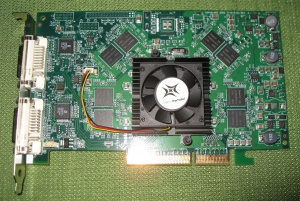Matrox
Contents
[hide]Chips
Impression
Millennium
Successor to the Impression series, Millennium is a capable VGA and GUI accelerator with good output quality. Its intended audience was CAD users and others who desired high-performance, high-resolution GUI acceleration and was highly-priced accordingly.
Like the Impression, it is a rudimentary 3D accelerator with support for gouraud shading. It does not support hardware texture mapping. It is not Direct3D compatible. There were a few games included with the card that interfaced with it.
Mystique
See main article: Matrox Mystique
Matrox Mystique is a 2D/3D/video accelerator for PC. Matrox released their first Mystique on August 14, 1996. Newer versions, including Mystique 220, kept appearing until summer 1997. The videocard usually had 2-4 Mb SGRAM expandable to 8MB with a special memory add-on card. However, apart from higher resolutions, upgrading memory did not make much difference.
Mystique was oriented on mid-end consummer and business market, offering excellent 2D performance, traditional for Matrox. It also has basic 3D capabilities, delivered mainly through Matrox Simple Interface API. As for the 2D part, it's safe to say the videocard has no known flaws. The image is crisp, has fine colors. But the 3D part lacked a lot of functions, which were removed to improve overall performance. Overall, Matrox Mystique is a good choice for 2D graphics alongside 3dfx Voodoo.
Millennium II
This chip is mysteriously similar to Mystique but it uses WRAM instead of SGRAM and this gives it higher high-resolution GUI performance. The 3D acceleration appears to be identical with even the same bugs.
It comes in both AGP and PCI versions.
G100
This was primarily a budget VGA/GUI "productivity" accelerator card. It has somewhat improved 3D hardware compared to the Mystique and Millennium II, with bilinear filtering, but it still lacks critical features like full alpha blending.
G200
The G200 is Matrox's first in-house 3D accelerator with full Direct3D 5 feature compliance. It typically comes with 8MB RAM and is capable of rendering at any resolution that can fit within that. It is capable of 32-bit rendering color depth although the performance hit is considerable. It is AGP 2x compliant and can use AGP texturing.
Unreal and Unreal Tournament may display an incorrect, overly bright image. Editing the Unreal.ini and disabling multi-texturing will fix this. Z-fighting may also be a problem and enabling 32-bit z-buffer can help this.
G200's OpenGL support was very poor until years into its life. Initially a slow OpenGL-to-Direct3D wrapper was used to support a few games. Eventually a full OpenGL driver was released at around the same time as G400's. Note that the final drivers for G200 include a OpenGL driver with a bug that breaks transparent water. This is remedied with later G400 driver package that contains a G200 OpenGL ICD. Overwrite the older ICD in the Windows directory.
Retail cards were Millennium G200, Mystique G200, Marvel G200 and G200 MMS. Millennium uses SGRAM while Mystique has slightly slower SDRAM but also TV-output. Marvel features video in/out capabilities. There is also a G250 chip which was OEM-only. It is built on 250nm manufacturing instead of G200's 350nm and typically does not need a heatsink.
G400
The G400 was essentially an improved and upgraded G200. Main improvements include 2 rendering pipelines, 128-bit memory bus, dual VGA monitor output, Direct3D 6 compliance, and environmental bump mapping support (EMBM). It is over twice as fast as Millennium G200. The G400 Max was similar in performance to TNT2 Ultra and Voodoo3 3500.
It lacks most DVD acceleration features but has an interesting DVD Max mode for output onto the second display.
Initially the card did not have an OpenGL driver. Matrox compensated for over a year with a miniGL called TurboGL which supported mainly Quake 1/2/3-based games. In early 2000 the final OpenGL driver was ready.
Variants include the Millennium G400, Millennium G400 Max, Marvel G400, and Marvel G400-TV. There are also a number of OEM models with different specifications. Some cards come with slightly slower SDRAM instead of SGRAM.
G450
A cost-reduced version of G400 with similar performance and features. G400 Max is faster.
Retail products were Millennium G450 and Marvel G450 eTV.
G550
A Direct3D 6 GPU in practice. It does have a hardware transform and lighting unit but it is not Direct3D 7 compliant. This was only used for the Headcasting software. Performance of this card is slightly above the G400 and G450.
The retail model was Millennium G550.
Parhelia
Matrox's first Direct3D 8 accelerator, although it was initially advertised has having partial D3D9 capabilities. Performance is similar to a GeForce4 Ti. Initial version of the GPU has some bugs with secondary displays and also shipped with a low clock speed because of manufacturing difficulties. A later version increased clock speeds but also eliminated AGP 2x (3.3v) support.
It features a unique anti-aliasing technique called fragment anti-aliasing that provides very high quality (claimed 16X-equivalent MSAA). This technique has some caveats though, such as incompatibility with stencil buffering, and so was not further developed.
The first Matrox chip with full DVD acceleration.
It does not support Windows 9x.
Parhelia-LX
This chip is designed to make Parhelia solutions more affordable. Key differences are:
- 128-bit memory bus instead of 256-bit
- 2 pixel pipelines instead of 4
One of the most common boards based on this logic was marketed as Matrox Millennium P650. It comes with dual DVI, 64MB of RAM and a fanless cooling system. It fairs well in period 3D-applications and games, although it will be slower than GeForce4 Ti most of the time. Like the Parhelia, these boards have no driver support for Windows 9x.
Video captures
Related links
- VOGONS threads about graphics cards
- MatroX Files - site with technical information about various Matrox cards. Includes overclocking, BIOS modification, tweaks, etc.
- Gona's PCI and AGP DOS game compatibility matrix






